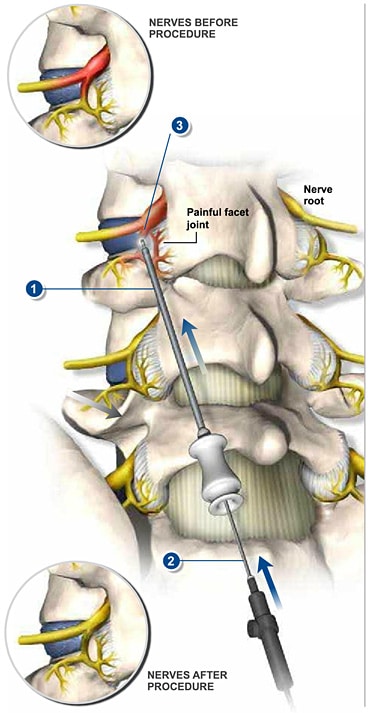 Stave off debilitating back pain for long periods of time
Stave off debilitating back pain for long periods of time
A rhizotomy addresses back pain due to facet joint syndrome. Facet joints line the back of your spine, both protecting your spinal column and stabilizing the vertebrae of your spine. Facet joints limit the flexibility in your back so you can’t fall over backward. When facet joints suffer injury or osteoarthritis, they can impinge on the nerves that exit your spinal column, causing pain.
Facet joint pain can originate in any part of your back or neck. It’s often shooting pain that gets worse when you move or bend a certain way. Sometimes, the pain (especially neck pain) can be a constant burning sensation. Pain from facet joint syndrome can appear in other parts of your body besides your neck and back too, since the root nerves at your spine are affected.
Testing for Facet Joint Syndrome
Once your doctor at the Southeastern Spine Institute (SSI) narrows down his diagnosis to facet joint syndrome, a rhizotomy is one option to eliminate that pain. But diagnosing the condition isn’t a straightforward process, since the symptoms of facet joint syndrome mimic other conditions, such as a herniated disc. To arrive at an accurate diagnosis, your doctor conducts one or more tests:
- X-rays of various angles of your back or neck
- Fluoroscopy, which provides more detailed information about your spine
- An MRI, to rule out other causes
- A facet joint injection, which confirms the exact source of your pain
Getting Pain Relief
The spine experts at SSI always take a more conservative approach to pain management. Even though it’s a minimally invasive procedure, a rhizotomy is not the first course of action to relieve your pain from facet joint syndrome. Facet joint injections, for example, can temporarily relieve your pain, but they’re not a long-term solution because of the steroids in the medication.
A rhizotomy, also called a facet rhizotomy or radiofrequency (RF) rhizotomy, works by “turning off” the pain-causing nerve. This procedure doesn’t deliver permanent pain relief either, but most often, it works for six months or longer. Undergoing this 30-minute procedure twice a year may be acceptable to you.
The Rhizotomy Procedure
For this outpatient procedure, you’re placed face down on an X-ray table. After applying a local anesthetic to your area of concern, your SSI doctor inserts a needle to reach the exact facet joint that’s the source of your pain. He uses fluoroscopy, which is a series of live X-rays, to guide his progress to the right spot.
Then an electrode is threaded through the needle. To test that the electrode is correctly positioned, your doctor may send a weak, brief current to the electrode, causing you to feel the same pain as you feel from your facet joint syndrome. Once you have confirmed that the needle is in the right spot, the electrode is heated by radiofrequency energy pulses. The heat cauterizes the nerve without burning it, stopping its ability to send pain signals to your brain.
Back pain can be debilitating. Whether you need a rhizotomy or some other kind of treatment, seek out the spinal medicine experts at the Southeastern Spine Institute for relief. Contact them today to get the pain relief you need to return to your normal life.
